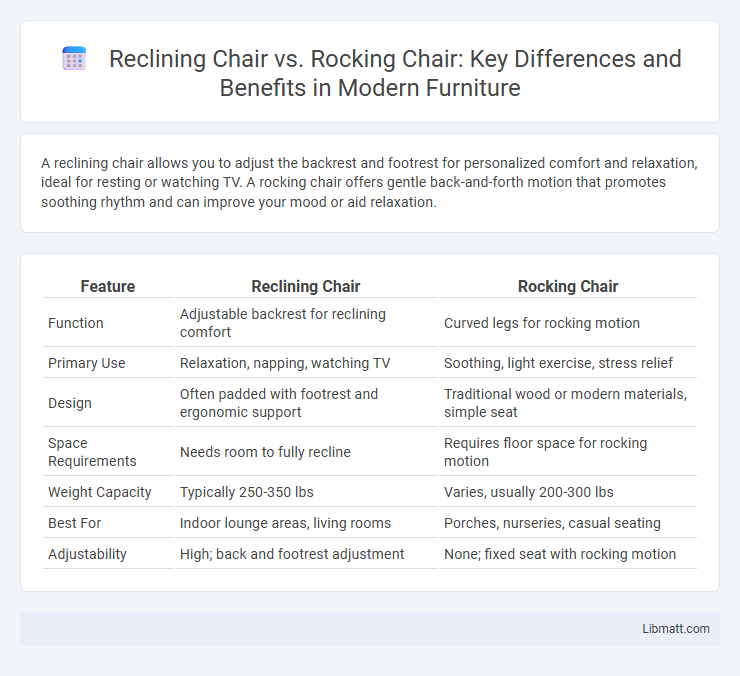A reclining chair allows you to adjust the backrest and footrest for personalized comfort and relaxation, ideal for resting or watching TV. A rocking chair offers gentle back-and-forth motion that promotes soothing rhythm and can improve your mood or aid relaxation.
Table of Comparison
| Feature | Reclining Chair | Rocking Chair |
|---|---|---|
| Function | Adjustable backrest for reclining comfort | Curved legs for rocking motion |
| Primary Use | Relaxation, napping, watching TV | Soothing, light exercise, stress relief |
| Design | Often padded with footrest and ergonomic support | Traditional wood or modern materials, simple seat |
| Space Requirements | Needs room to fully recline | Requires floor space for rocking motion |
| Weight Capacity | Typically 250-350 lbs | Varies, usually 200-300 lbs |
| Best For | Indoor lounge areas, living rooms | Porches, nurseries, casual seating |
| Adjustability | High; back and footrest adjustment | None; fixed seat with rocking motion |
Introduction to Reclining and Rocking Chairs
Reclining chairs feature adjustable backrests and footrests designed for enhanced comfort and relaxation, often incorporating ergonomic support and manual or electric reclining mechanisms. Rocking chairs consist of curved legs that allow gentle back-and-forth motion, promoting soothing movement and stress relief. Both types of chairs offer unique benefits for home or office settings, catering to different user preferences in comfort and functionality.
Design and Functionality Comparison
Reclining chairs feature adjustable backrests and footrests designed for personalized comfort and relaxation, often incorporating padded cushioning and ergonomic support. Rocking chairs have curved legs that enable a smooth rocking motion, promoting gentle movement and soothing rhythm without adjustable components. The design focus of reclining chairs is on customizable positioning, while rocking chairs emphasize continuous rocking motion for stress relief and comfort.
Comfort Levels: Recliner vs Rocker
Reclining chairs offer adjustable backrests and footrests that provide customizable comfort, making them ideal for prolonged relaxation and support. Rocking chairs promote gentle, rhythmic motion, which can soothe and reduce stress but typically lack adjustable features for personalized positioning. While recliners maximize ergonomic comfort through various angles and cushioning, rocking chairs prioritize motion-based comfort that appeals to users seeking calming movement.
Space and Placement Considerations
Reclining chairs typically require more space due to their extended footrests and adjustable backrests, making them ideal for larger rooms or dedicated relaxation areas. Rocking chairs have a more compact footprint and can fit comfortably in smaller spaces like nurseries or cozy corners, but need clearance for the rocking motion. When choosing between the two, consider your room size and available placement options to ensure Your furniture complements the space without hindering movement.
Material and Build Quality Differences
Reclining chairs typically feature sturdy metal or hardwood frames combined with high-density foam cushioning for enhanced comfort and durability. Rocking chairs often use solid wood or bentwood construction, emphasizing flexible curved rockers and lightweight design for smooth motion. The reclining mechanism incorporates metal hinges and levers, whereas rocking chairs rely solely on the curved base for movement, reflecting distinct approaches in build quality and materials.
Health and Ergonomic Benefits
A reclining chair promotes spinal alignment and reduces pressure on the lower back, enhancing overall comfort and reducing muscle strain during extended sitting. Rocking chairs stimulate gentle motion that improves circulation and decreases stress by encouraging relaxation and rhythmic movement. Both chair types support ergonomic health by offering customizable seating positions that alleviate joint stiffness and promote better posture.
Style and Aesthetic Appeal
Reclining chairs offer a sleek, modern aesthetic with smooth lines and plush cushioning that enhance comfort and sophistication in any living space. Rocking chairs present a classic, timeless charm with their curved rockers and traditional wood or metal finishes, often evoking a sense of relaxation and nostalgia. Your choice depends on whether you prefer contemporary elegance or rustic warmth to complement your room's style.
Maintenance and Durability
Reclining chairs typically require regular maintenance of the mechanical parts and upholstery to ensure long-term durability, especially if equipped with electronic reclining mechanisms. Rocking chairs are often more durable due to their simpler design and fewer moving parts, requiring occasional tightening of screws and cleaning to maintain stability. Your choice should consider the maintenance effort you're willing to commit, as rocking chairs generally offer easier upkeep compared to reclining chairs.
Price Range and Value for Money
Reclining chairs typically range from $200 to $1,500 depending on features like motorized controls and upholstery quality, offering excellent value for those seeking comfort and adjustable positions. Rocking chairs are generally more affordable, with prices spanning $100 to $600, providing classic relaxation and durability, especially in wooden or high-quality crafted models. Your choice should consider how much you prioritize adjustable comfort versus traditional design to maximize value for money.
Which Chair Suits Your Lifestyle?
Reclining chairs offer adjustable comfort ideal for relaxation and activities like reading or watching TV, making them perfect for those seeking personalized support and stress relief. Rocking chairs provide gentle back-and-forth motion that soothes and promotes calmness, ideal for users who enjoy rhythmic movement and a more traditional aesthetic. Your choice depends on whether you prioritize adjustable lounging features or a comforting, repetitive rocking experience to suit your lifestyle.
Reclining Chair vs Rocking Chair Infographic

 libmatt.com
libmatt.com